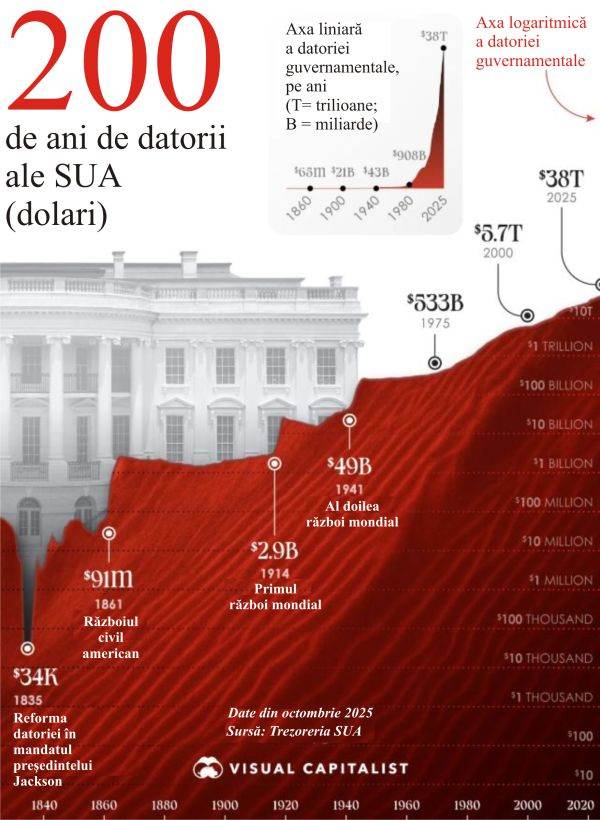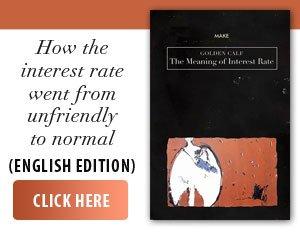Estimates show that by 2035, net interest payments on the US debt will represent 22.2% of federal revenue. With the US debt currently at about $38 trillion, these interest costs are expected to reach $952 billion in 2025, tripling in nearly five years, according to visualcapitalist.com, which charts the evolution of the US debt from 1825 to the present, based on US Treasury data. According to the cited source, these costs will reach $1.8 trillion in ten years, further reducing the federal budget.
• A Brief History of US Debt
The cited source shows how America's national debt burden has evolved over the past two centuries, increasing nearly sevenfold in 25 years. In large part, this has been driven by the central bank (Fed) printing trillions of dollars in the wake of the 2008 financial crisis and the pandemic era. In 2020 alone, the Fed printed $3 trillion under its quantitative easing program. Before these crises, the strategy of printing money was unusual, but since then it has become a primary tool used by the central bank.
Looking back to mid-century America, we can see that the debt rose from $83.8 billion in 1825 to $257 billion in 1950 and $533 billion in 1975. Thanks to decades of strong economic growth, the debt actually fell from 106% of GDP in 1946 to just 23% in 1974, a figure almost unthinkable today. It is also worth noting that the US debt was almost completely eliminated at one point in American history. In 1835, under President Andrew Jackson, it fell to $34,000, down from $4.8 million the previous year. Specifically, President Jackson relied on tariffs and the sale of state land to raise revenue and reduce the national debt. But these policies later helped trigger the 1837 financial crisis, amid a rising housing bubble.
• US debt tops $38 trillion
The US national debt topped $38 trillion last week as the gap between government spending and revenue in the world's largest economy widens rapidly.
The US Treasury Department included the staggering figure in its latest report on the nation's finances, putting the debt at $38,019,813,354,700.26, aljazeera.com notes. That works out to about $111,000 in debt for every person in the US and is equivalent to the value of the economies of China, India, Japan, Germany and the United Kingdom combined, according to the Peter G. Peterson Foundation, a Washington, DC-based think tank.
The milestone comes just over two months after the U.S. debt topped $37 trillion in mid-August. The debt was set to reach $36 trillion in November 2024 and $35 trillion in July.
Michael A. Peterson, CEO of the Peter G. Peterson Foundation, said U.S. lawmakers are failing in their "basic fiscal responsibilities.” "Adding trillions upon trillions to the debt and budgeting for the crisis is no way for a nation as great as America to manage its finances,” Peterson said in a statement, adding, "Lawmakers should seize the many responsible reforms that would put our nation on a better path for the future.”
In May, Moody's downgraded the U.S. government's credit rating from "Aaa" to "Aa1," citing the failure of successive administrations to "reverse the trend of large annual fiscal deficits and rising interest costs." The move followed similar downgrades by Fitch and Standard & Poor's in 2011 and 2023, respectively.
While there is debate among economists about how much debt the U.S. can accumulate before a financial crisis erupts, there is broad consensus that the current trajectory is unsustainable.
In a 2023 analysis, economists at the Penn Wharton Budget Model estimated that financial markets would not tolerate levels of U.S. debt above 200% of GDP.
The Congressional Budget Office, a nonpartisan organization, has estimated that the debt could reach 200% of GDP by 2047, partly due to the drastic tax cuts included in US President Donald Trump's "One Big Beautiful Bill Act.”




























































1. So what?
(message sent by Donald on 29.10.2025, 06:09)
The US will never ever pay this debt and never intended to pay it. printing money is the only way US is growing and remains in business. All is just a BIG LIE! One day all this will come crushing down and this will destabilize the entire world!